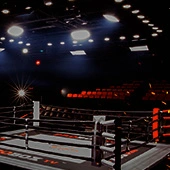By Cliff Rold
There are plenty of guys with belts in boxing. There are only a handful of fighters who stand out as the legitimate World Champions of their class. Two of them, World Super Middleweight (168 lbs.) Champion Andre Ward and World Light Heavyweight Champion (175 lbs.) Chad Dawson, will lock horns this Saturday night at the Oracle Arena in Oakland, California.
In terms of the scale, this isn’t anything fans aren’t used to. In an era where pound-for-pound gets more run than it merits, and fighters pack careers into lower volumes of significant fights, there is almost an expectation that fighters will move up the scale in search of new challenges. After Andre Ward finished his run in the Super Six Super Middleweight tournament, winning two alphabet straps and reestablishing the lineage of his division left vacant by Joe Calzaghe, one could assume the clock was ticking.
So, it is no surprise that Ward will be moving up to…
…wait…
…scratch that.
That’s now what’s happening.
The title on the line this weekend does not belong to the bigger man. When he laid down the gauntlet to Ward, Dawson said he’d be willing to come down the scale. Ward liked those terms. After some early speculation that both men would put their titles on the line, we instead have the man from the larger class challenging the smaller for his crown.
It is a rare twist on the division hopping the sport has grown accustomed to, something seldom seen or attempted. Should Dawson win, he will join a rare cadre of World Champions who have moved down the scale to capture an additional crown. He would be joining fine company.
The standard for the slide down was set well over a century ago by “Ruby Robert.” After capturing the Middleweight crown from “The Nonpareil” Jack Dempsey in 1891, Bob Fitzsimmons vacated the crown in 1895 to pursue bigger game. The gamble paid off in 1897 when, behind on points, Fitzsimmons landed one of the most famous body shots of all time and wrested the Heavyweight crown from Jim Corbett.
Fitzsimmons held the crown until 1899, stopped by James Jeffries. Unable to regain the crown in a return, one could have assumed the title days of Fitzsimmons behind him but the sport was growing and so to was the proliferation of weight divisions. Light Heavyweight was born in 1903, Jack Root scoring a decision over Charles “Kid” McCoy to birth the crown. He held it only long enough to lose his first defense to George Gardner.
Gardner, perhaps believing time was literally on his side, chose his first defense against a then 40-year old Fitzsimmons. Fitzsimmons, still spry and with the stamina to last, won the fledgling title with a decision over twenty rounds.
Of course, the move down was a matter of divisional name more than body mass. Fitzsimmons, who never weighed much more in his career than the lower-to-mid 170s, didn’t have to move his body much for Gardner. Fighting at a Light Heavyweight limit then set at 170 lbs., both Fitzsimmons and Gardner weighed in at 168 lbs. for their fight. It was a pound more than Fitzsimmons had weighed when he defeated a 184-lb. Corbett for the Heavyweight throne.
Henry Armstrong pulled off the task in a different fashion. First capturing the Featherweight crown at 124 lbs. in 1937, he jumped all the way to Welterweight to unseat the great Barney Ross the following year. Armstrong pulled the feat weighing only 133 ½ to Ross’s 142. In his following fight, weighing a half-pound more, he tackled Lightweight king Lou Ambers to finish his historic trifecta of holding the Featherweight, Lightweight, and Welterweight crowns simultaneously.
Fitzsimmons and Armstrong both won undisputed crowns to pull of their feats. There are others who settled for shares of divisional crowns for their own personal pieces of history.
In more recent vintage, Thomas Hearns made a massive leap in terms of divisions to add to what would ultimately be titles in five divisions. After failing to win the Middleweight crown from Marvin Hagler in 1985, the former Welterweight and Jr. Middleweight champ returned briefly to 154 lbs. before going up to face rugged WBC 175 lb. titlist Dennis Andries. Scoring a tenth-round knockout in 1987, Hearns would then return to Middleweight in his next fight that year to stop Juan Roldan for a WBC belt left vacant in the wake of Hagler-Sugar Ray Leonard. Hearns bulked all the way up to 173 ¼ before coming back to 159 ½ lbs.
Leonard, who famously won Super Middleweight and Light Heavyweight belts against Donny LaLonde on the same night, was the reigning WBC and lineal Welterweight king when he moved up to defeat WBA and lineal Jr. Middleweight champion Ayub Kalule before dropping back down to unify the Welterweight division against Hearns, taking Hearns’ WBA belt in a 1981 classic.
There have been others.
Emile Griffith won an early version of the Jr. Middleweight crown but didn’t hold it long before returning to defend his Welterweight crown.
Pernell Whitaker moved up to take a WBA Jr. Middleweight belt from Julio Cesar Vazquez in 1995 before resuming a reign as the WBC and lineal Welterweight champion that lasted from 1993-1997.
Roy Jones won the WBA Heavyweight belt from John Ruiz before returning to defend his Ring Magazine Light Heavyweight belt, recapturing WBC and WBA belts in the process. Both feats came in 2003.
Shane Mosley, a former Welterweight champion, won and lost the lineal Jr. Middleweight crown in 2003 and 2004 before adding a final WBC crown at Welterweight crown with a win over Antonio Margarito in 2009. The historical website, www.cyberboxingzone.com , recognizes Mosley-Margarito as for the then-vacant lineal Welterweight crown.
Later this year, Ivan Calderon will attempt to add a title to his mantle in his original class. The long reigning 105 lb. beltholder moved up for a solid lineal and WBO reign at 108 lbs. Stopped twice by Giovanni Segura, he now will challenge Moises Fuentes for the WBO 105 lbs. strap. He won’t be favored, but the chance exists for success.
Until then, we have Dawson.
Dawson hasn’t weighed 168 since 2006, and hasn’t been lower than 173 since 2007. It’s a bold stroke and it’s not something we see often. When championship fighters go up the scale, they usually stay there. It is the rare fighter who can pull it off the other direction. For Dawson, the silver ling beyond victory itself could be this:
Look at all those names again. There isn’t one who isn’t in, or likely to be enshrined in, the Hall of Fame. If Dawson can move down to add Ward to a list of victories that already includes Tomasz Adamek, Glen Johnson, Antonio Tarver, and Bernard Hopkins, he’ll have taken a massive step towards Canastota.
Cliff Rold is the Managing Editor of BoxingScene and a member of the Yahoo Pound for Pound voting panel and the Boxing Writers Association of America. He can be reached at roldboxing@hotmail.com


